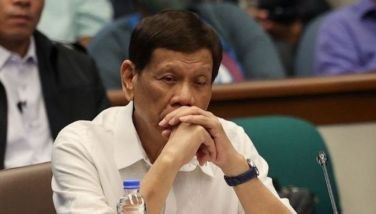‘The Firm’ wins for government
Villaraza Cruz Marcelo & Angangco (CVCLaw), more popularly known as “The Firm,” scored a victory for the government – and consequently the public – with the Court of Appeals’ decision to overturn a January 27, 2012 ruling ordering the Bangko Sentral to reopen the Aguirre-owned Banco Filipino Savings and Mortgage Bank (BF). Penned by CA Associate Justice Noel Tijam and promulgated last Nov. 21, the decision “reversed and set aside” the January decision, stating that the CA did not find grave abuse of discretion on the part of the BSP, the Monetary Board and the Philippine Deposit Insurance Corp. (PDIC) in ordering the closure of Banco Filipino.
Contrary to BF allegations that it was not accorded due process, the CA, in its ruling, pointed out the presence of the bank’s department heads during the pre-exit conference, as well as the attendance of BF senior management and two of its directors during the final exit conference conducted by the regulator – were clearly in “observance of due process materially dispelling the claim that there was undue haste in placing Banco Filipino under receivership.”
BF and its long-running corporate saga has put depositors on a seesaw, with the bank first ordered closed in 1985, then reopened in 1994 after the Supreme Court annulled the closure order in 1991. In September 2010 however, BSP examination teams found BF “unable to pay its liabilities as they become due… has insufficient realizable assets to meet liabilities… and cannot continue its business without involving probable losses to its depositors and creditors considering the failure of its Board of Directors/management to restore the bank’s financial health and viability despite considerable time given to address the bank’s financial problems…”
The findings were contained in a March 2011 memo which, among other things, recommended that BF be placed under receivership with PDIC. BF disputed this, blaming its financial problems to an alleged smear campaign and the BSP’s refusal to grant an emergency P25 billion loan. Tijam ruled, however, that BSP’s actions were in accordance with its regular and lawful functions, having the authority to investigate to see whether an institution is compliant with laws and regulations – a “valid exercise of discretion as they are suitable and reasonable processes” with “no abuse of discretion, much less grave, correctible by certiorari.” The amended decision cited PDIC findings that BF’s assets amounted to P11.77 billion but had liabilities of P23.02 billion (as of its closure date). Subsequent reports (as of May 2011) revealed BF’s assets as deficient by P13.93 billion – definitely not enough to cover its liabilities reaching P23.6 billion. Thus, the bank “cannot be allowed to continue its business” as it places its depositors, creditors and the public at risk.
But what the appellate court particularly found disturbing, however, is “Banco Filipino’s admission that even if respondents BSP-MB gave Banco Filipino the sought emergency loan, such amount will just be exhausted in a matter of days in view of the deposits which the bank currently services for its depositors…” with an expected flock of withdrawals the minute news of the bank’s reopening came out, the CA noted. The appellate court also slammed BF’s rehabilitation proposal involving P45.8 billion whose funding will come exclusively from the government – with stockholders maintaining that they will not dish out anything from their own pockets to rehabilitate Banco Filipino. Citing another case, the CA came to the assumption that “the only thing the stockholders are gunning for is the recovery of their investments or a portion thereof after the corporate debts are satisfied…” – “a selfish venture” that the court “cannot sanction.”
No strategic investors have also expressed interest in rehabilitating the bank, making it appear that BF was solely reliant on public funds through BSP loan grants – a dole-out at public expense with no definite guarantee of return, the ruling said. “Consequently, We cannot find sufficient ground to uphold this Court’s Jan. 27, 2011 decision not only for want of material basis under the facts, the law and jurisprudence, but more importantly, for being fraught with uncertainties. Unless the Banco Filipino can specify its independent and strong financial commitment to address its present predicament, We do not see any cogent reason to sustain its sought rehabilitation, much less its re-opening at this time,” the CA concluded.
Big bank, small problem
The proposed merger deal between the Philippine National Bank and the Bank of the Philippine Islands could give birth to the country’s biggest lender, with PNB assets placed at over P304 billion while BPI’s is estimated at more than P720 billion. With PNB in the process of completing its merger with Allied Bank (also owned by tycoon Lucio Tan with assets estimated at P176.7 billion), the BPI-PNB deal – which is currently in limbo – could create a giant institution with P1.2 trillion in combined assets.
A “slight problem” that is keeping the merger from being consummated, however, has to do with issues within the family of Kapitan, with disagreements over who gets to occupy seats in the Board or who will be granted committee memberships in the merged entity.
Spy tidbit
Latina Jennifer Lopez’s concert last night at the Mall of Asia (MOA) Arena was one of the most successful and biggest shows ever, with VIP seats priced at over P25,000 the first to be sold out days after the concert was announced. The hefty ticket prices (with the general admission tickets still pricey at P2,500) did not deter diehard fans from watching the one-night-only Manila leg of JLo’s “Dance Again” world tour. No wonder Hans Sy couldn’t help smiling. Apparently, the success of the JLo concert has taken out the “Sting” from the aborted MOA concert of the “Englishman in New York.”
***
Email: spybits08@yahoo.com.
- Latest
- Trending




























